Toddler Learning Experience: Documentation of the Planning Cycle
VerifiedAdded on 2023/06/11
|9
|2985
|50
Practical Assignment
AI Summary
This assignment documents a planning cycle for a toddler learning experience centered around play-based learning with sand. The observation phase identifies how toddlers engage with the activity, influence each other, and demonstrate creativity. The analysis highlights the children's strengths, weaknesses, and alignment with the Early Years Learning Framework (EYLF). The planning phase outlines strategies such as team working, questioning, and scaffolding to enhance learning. Implementation focuses on leveraging the teacher's experience, improving skills like positivity and time management, and fostering problem-solving through inquiry. The document emphasizes creating a comfortable and attractive environment to maximize learning outcomes and engagement among toddlers. Desklib offers more resources like this to aid students in their studies.
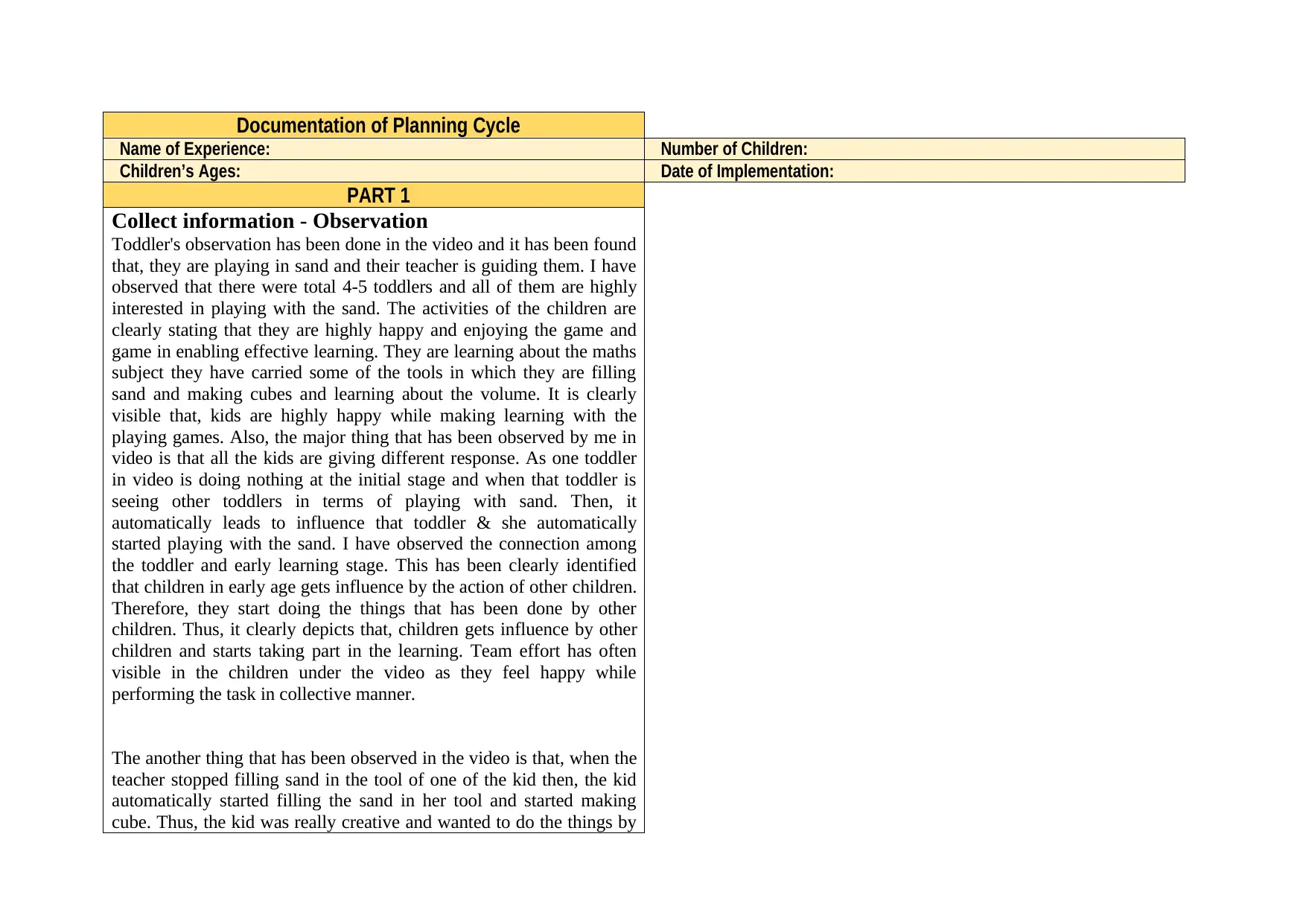
Documentation of Planning Cycle
Name of Experience: Number of Children:
Children’s Ages: Date of Implementation:
PART 1
Collect information - Observation
Toddler's observation has been done in the video and it has been found
that, they are playing in sand and their teacher is guiding them. I have
observed that there were total 4-5 toddlers and all of them are highly
interested in playing with the sand. The activities of the children are
clearly stating that they are highly happy and enjoying the game and
game in enabling effective learning. They are learning about the maths
subject they have carried some of the tools in which they are filling
sand and making cubes and learning about the volume. It is clearly
visible that, kids are highly happy while making learning with the
playing games. Also, the major thing that has been observed by me in
video is that all the kids are giving different response. As one toddler
in video is doing nothing at the initial stage and when that toddler is
seeing other toddlers in terms of playing with sand. Then, it
automatically leads to influence that toddler & she automatically
started playing with the sand. I have observed the connection among
the toddler and early learning stage. This has been clearly identified
that children in early age gets influence by the action of other children.
Therefore, they start doing the things that has been done by other
children. Thus, it clearly depicts that, children gets influence by other
children and starts taking part in the learning. Team effort has often
visible in the children under the video as they feel happy while
performing the task in collective manner.
The another thing that has been observed in the video is that, when the
teacher stopped filling sand in the tool of one of the kid then, the kid
automatically started filling the sand in her tool and started making
cube. Thus, the kid was really creative and wanted to do the things by
Name of Experience: Number of Children:
Children’s Ages: Date of Implementation:
PART 1
Collect information - Observation
Toddler's observation has been done in the video and it has been found
that, they are playing in sand and their teacher is guiding them. I have
observed that there were total 4-5 toddlers and all of them are highly
interested in playing with the sand. The activities of the children are
clearly stating that they are highly happy and enjoying the game and
game in enabling effective learning. They are learning about the maths
subject they have carried some of the tools in which they are filling
sand and making cubes and learning about the volume. It is clearly
visible that, kids are highly happy while making learning with the
playing games. Also, the major thing that has been observed by me in
video is that all the kids are giving different response. As one toddler
in video is doing nothing at the initial stage and when that toddler is
seeing other toddlers in terms of playing with sand. Then, it
automatically leads to influence that toddler & she automatically
started playing with the sand. I have observed the connection among
the toddler and early learning stage. This has been clearly identified
that children in early age gets influence by the action of other children.
Therefore, they start doing the things that has been done by other
children. Thus, it clearly depicts that, children gets influence by other
children and starts taking part in the learning. Team effort has often
visible in the children under the video as they feel happy while
performing the task in collective manner.
The another thing that has been observed in the video is that, when the
teacher stopped filling sand in the tool of one of the kid then, the kid
automatically started filling the sand in her tool and started making
cube. Thus, the kid was really creative and wanted to do the things by
Secure Best Marks with AI Grader
Need help grading? Try our AI Grader for instant feedback on your assignments.
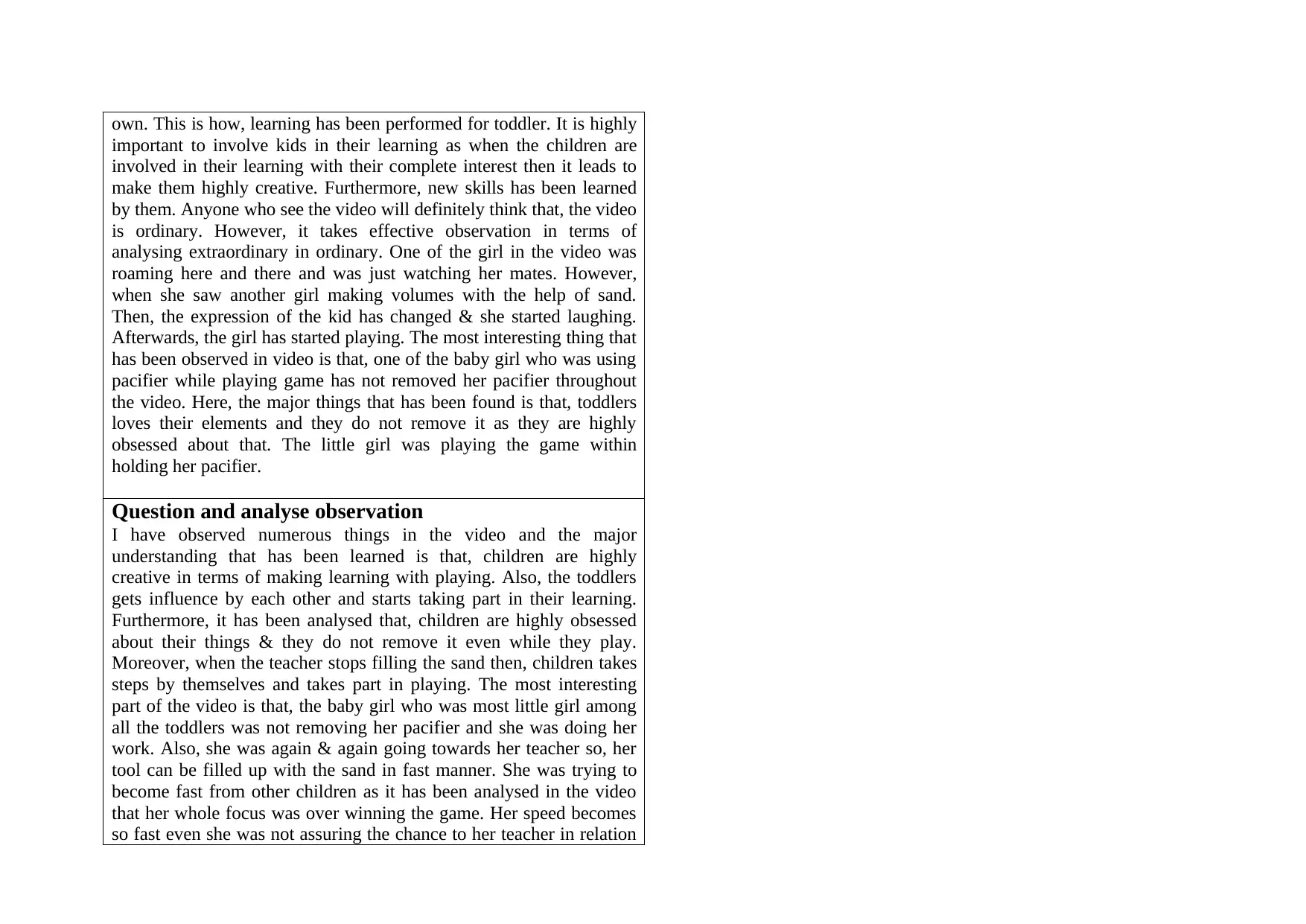
own. This is how, learning has been performed for toddler. It is highly
important to involve kids in their learning as when the children are
involved in their learning with their complete interest then it leads to
make them highly creative. Furthermore, new skills has been learned
by them. Anyone who see the video will definitely think that, the video
is ordinary. However, it takes effective observation in terms of
analysing extraordinary in ordinary. One of the girl in the video was
roaming here and there and was just watching her mates. However,
when she saw another girl making volumes with the help of sand.
Then, the expression of the kid has changed & she started laughing.
Afterwards, the girl has started playing. The most interesting thing that
has been observed in video is that, one of the baby girl who was using
pacifier while playing game has not removed her pacifier throughout
the video. Here, the major things that has been found is that, toddlers
loves their elements and they do not remove it as they are highly
obsessed about that. The little girl was playing the game within
holding her pacifier.
Question and analyse observation
I have observed numerous things in the video and the major
understanding that has been learned is that, children are highly
creative in terms of making learning with playing. Also, the toddlers
gets influence by each other and starts taking part in their learning.
Furthermore, it has been analysed that, children are highly obsessed
about their things & they do not remove it even while they play.
Moreover, when the teacher stops filling the sand then, children takes
steps by themselves and takes part in playing. The most interesting
part of the video is that, the baby girl who was most little girl among
all the toddlers was not removing her pacifier and she was doing her
work. Also, she was again & again going towards her teacher so, her
tool can be filled up with the sand in fast manner. She was trying to
become fast from other children as it has been analysed in the video
that her whole focus was over winning the game. Her speed becomes
so fast even she was not assuring the chance to her teacher in relation
important to involve kids in their learning as when the children are
involved in their learning with their complete interest then it leads to
make them highly creative. Furthermore, new skills has been learned
by them. Anyone who see the video will definitely think that, the video
is ordinary. However, it takes effective observation in terms of
analysing extraordinary in ordinary. One of the girl in the video was
roaming here and there and was just watching her mates. However,
when she saw another girl making volumes with the help of sand.
Then, the expression of the kid has changed & she started laughing.
Afterwards, the girl has started playing. The most interesting thing that
has been observed in video is that, one of the baby girl who was using
pacifier while playing game has not removed her pacifier throughout
the video. Here, the major things that has been found is that, toddlers
loves their elements and they do not remove it as they are highly
obsessed about that. The little girl was playing the game within
holding her pacifier.
Question and analyse observation
I have observed numerous things in the video and the major
understanding that has been learned is that, children are highly
creative in terms of making learning with playing. Also, the toddlers
gets influence by each other and starts taking part in their learning.
Furthermore, it has been analysed that, children are highly obsessed
about their things & they do not remove it even while they play.
Moreover, when the teacher stops filling the sand then, children takes
steps by themselves and takes part in playing. The most interesting
part of the video is that, the baby girl who was most little girl among
all the toddlers was not removing her pacifier and she was doing her
work. Also, she was again & again going towards her teacher so, her
tool can be filled up with the sand in fast manner. She was trying to
become fast from other children as it has been analysed in the video
that her whole focus was over winning the game. Her speed becomes
so fast even she was not assuring the chance to her teacher in relation
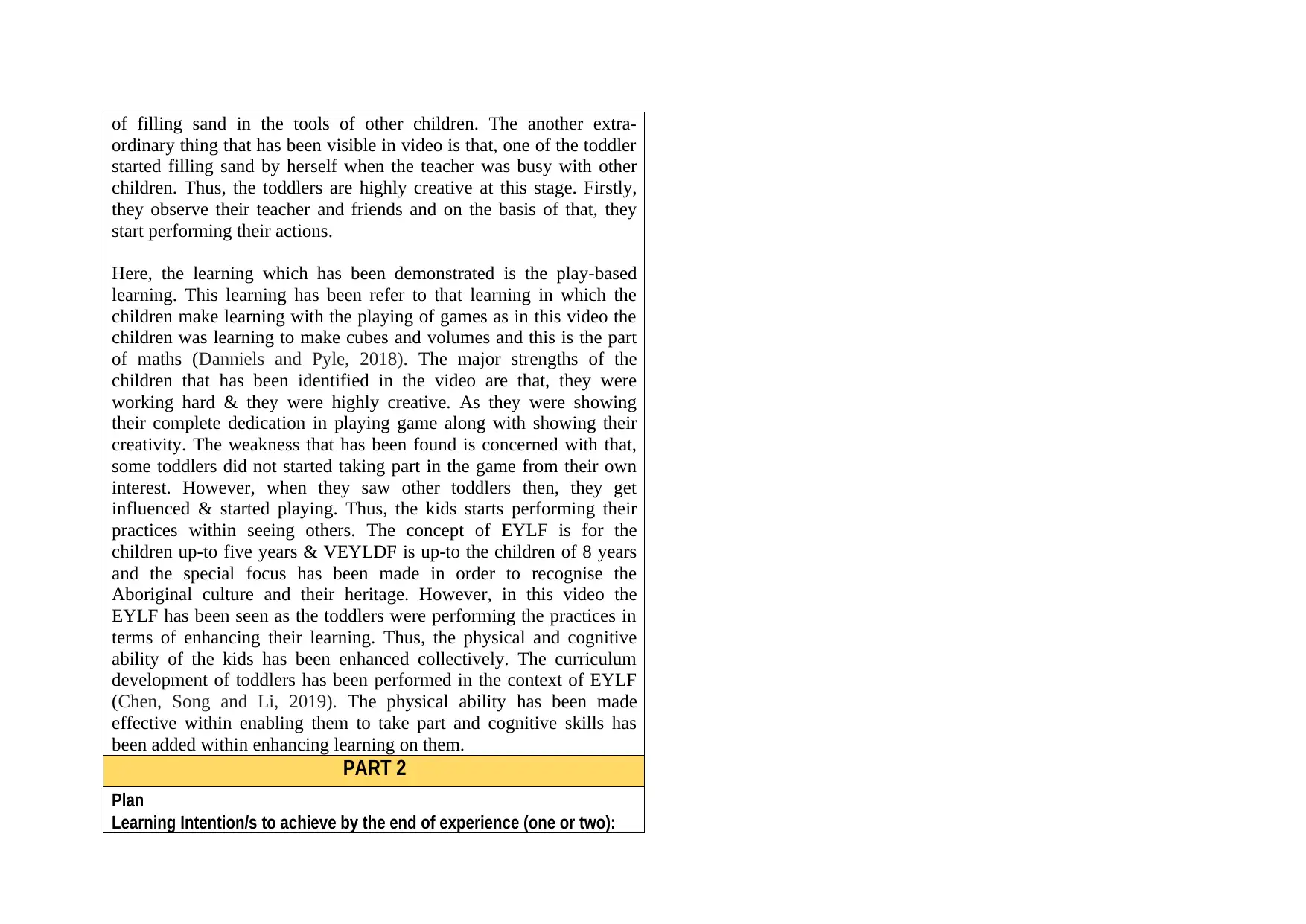
of filling sand in the tools of other children. The another extra-
ordinary thing that has been visible in video is that, one of the toddler
started filling sand by herself when the teacher was busy with other
children. Thus, the toddlers are highly creative at this stage. Firstly,
they observe their teacher and friends and on the basis of that, they
start performing their actions.
Here, the learning which has been demonstrated is the play-based
learning. This learning has been refer to that learning in which the
children make learning with the playing of games as in this video the
children was learning to make cubes and volumes and this is the part
of maths (Danniels and Pyle, 2018). The major strengths of the
children that has been identified in the video are that, they were
working hard & they were highly creative. As they were showing
their complete dedication in playing game along with showing their
creativity. The weakness that has been found is concerned with that,
some toddlers did not started taking part in the game from their own
interest. However, when they saw other toddlers then, they get
influenced & started playing. Thus, the kids starts performing their
practices within seeing others. The concept of EYLF is for the
children up-to five years & VEYLDF is up-to the children of 8 years
and the special focus has been made in order to recognise the
Aboriginal culture and their heritage. However, in this video the
EYLF has been seen as the toddlers were performing the practices in
terms of enhancing their learning. Thus, the physical and cognitive
ability of the kids has been enhanced collectively. The curriculum
development of toddlers has been performed in the context of EYLF
(Chen, Song and Li, 2019). The physical ability has been made
effective within enabling them to take part and cognitive skills has
been added within enhancing learning on them.
PART 2
Plan
Learning Intention/s to achieve by the end of experience (one or two):
ordinary thing that has been visible in video is that, one of the toddler
started filling sand by herself when the teacher was busy with other
children. Thus, the toddlers are highly creative at this stage. Firstly,
they observe their teacher and friends and on the basis of that, they
start performing their actions.
Here, the learning which has been demonstrated is the play-based
learning. This learning has been refer to that learning in which the
children make learning with the playing of games as in this video the
children was learning to make cubes and volumes and this is the part
of maths (Danniels and Pyle, 2018). The major strengths of the
children that has been identified in the video are that, they were
working hard & they were highly creative. As they were showing
their complete dedication in playing game along with showing their
creativity. The weakness that has been found is concerned with that,
some toddlers did not started taking part in the game from their own
interest. However, when they saw other toddlers then, they get
influenced & started playing. Thus, the kids starts performing their
practices within seeing others. The concept of EYLF is for the
children up-to five years & VEYLDF is up-to the children of 8 years
and the special focus has been made in order to recognise the
Aboriginal culture and their heritage. However, in this video the
EYLF has been seen as the toddlers were performing the practices in
terms of enhancing their learning. Thus, the physical and cognitive
ability of the kids has been enhanced collectively. The curriculum
development of toddlers has been performed in the context of EYLF
(Chen, Song and Li, 2019). The physical ability has been made
effective within enabling them to take part and cognitive skills has
been added within enhancing learning on them.
PART 2
Plan
Learning Intention/s to achieve by the end of experience (one or two):
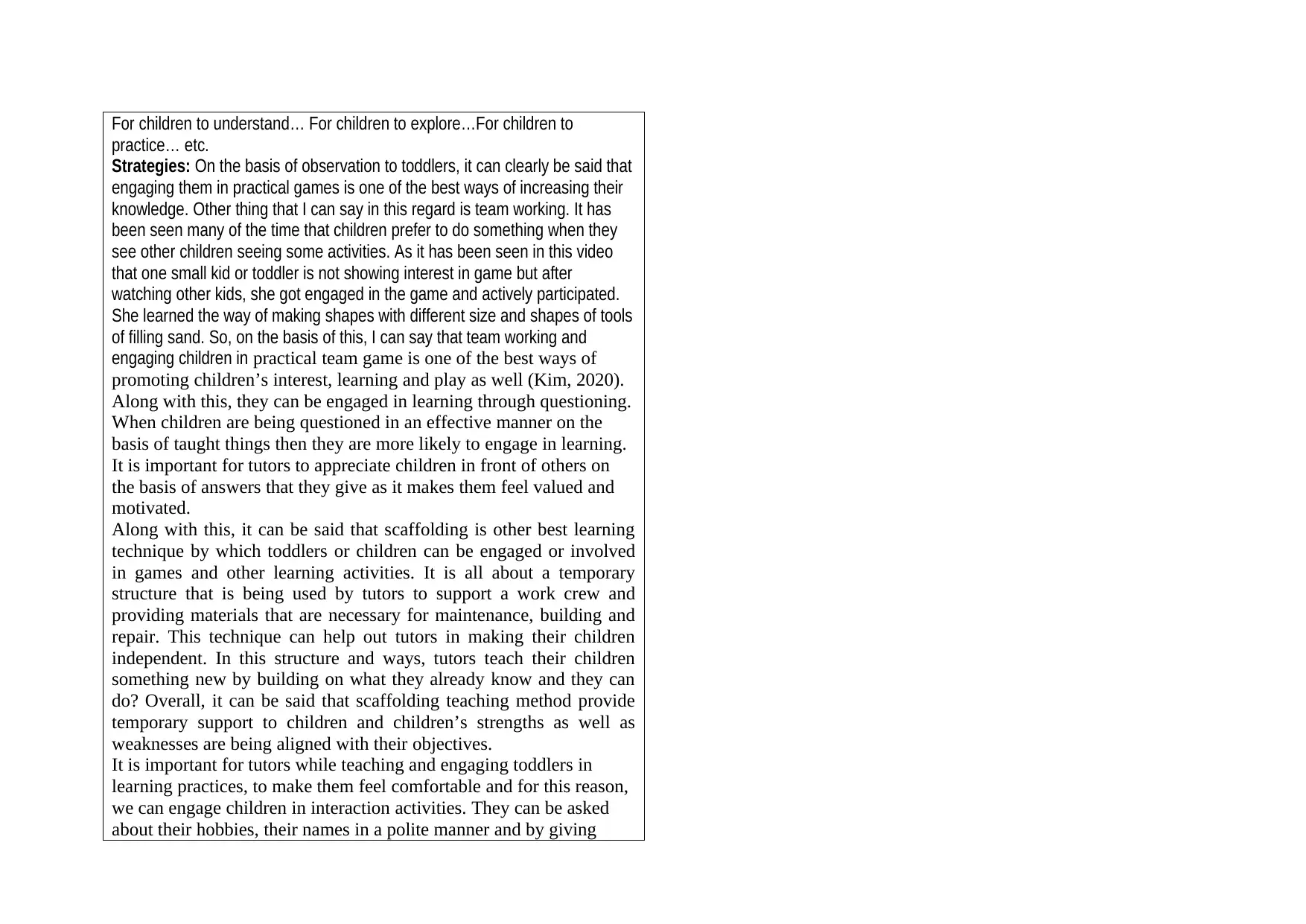
For children to understand… For children to explore…For children to
practice… etc.
Strategies: On the basis of observation to toddlers, it can clearly be said that
engaging them in practical games is one of the best ways of increasing their
knowledge. Other thing that I can say in this regard is team working. It has
been seen many of the time that children prefer to do something when they
see other children seeing some activities. As it has been seen in this video
that one small kid or toddler is not showing interest in game but after
watching other kids, she got engaged in the game and actively participated.
She learned the way of making shapes with different size and shapes of tools
of filling sand. So, on the basis of this, I can say that team working and
engaging children in practical team game is one of the best ways of
promoting children’s interest, learning and play as well (Kim, 2020).
Along with this, they can be engaged in learning through questioning.
When children are being questioned in an effective manner on the
basis of taught things then they are more likely to engage in learning.
It is important for tutors to appreciate children in front of others on
the basis of answers that they give as it makes them feel valued and
motivated.
Along with this, it can be said that scaffolding is other best learning
technique by which toddlers or children can be engaged or involved
in games and other learning activities. It is all about a temporary
structure that is being used by tutors to support a work crew and
providing materials that are necessary for maintenance, building and
repair. This technique can help out tutors in making their children
independent. In this structure and ways, tutors teach their children
something new by building on what they already know and they can
do? Overall, it can be said that scaffolding teaching method provide
temporary support to children and children’s strengths as well as
weaknesses are being aligned with their objectives.
It is important for tutors while teaching and engaging toddlers in
learning practices, to make them feel comfortable and for this reason,
we can engage children in interaction activities. They can be asked
about their hobbies, their names in a polite manner and by giving
practice… etc.
Strategies: On the basis of observation to toddlers, it can clearly be said that
engaging them in practical games is one of the best ways of increasing their
knowledge. Other thing that I can say in this regard is team working. It has
been seen many of the time that children prefer to do something when they
see other children seeing some activities. As it has been seen in this video
that one small kid or toddler is not showing interest in game but after
watching other kids, she got engaged in the game and actively participated.
She learned the way of making shapes with different size and shapes of tools
of filling sand. So, on the basis of this, I can say that team working and
engaging children in practical team game is one of the best ways of
promoting children’s interest, learning and play as well (Kim, 2020).
Along with this, they can be engaged in learning through questioning.
When children are being questioned in an effective manner on the
basis of taught things then they are more likely to engage in learning.
It is important for tutors to appreciate children in front of others on
the basis of answers that they give as it makes them feel valued and
motivated.
Along with this, it can be said that scaffolding is other best learning
technique by which toddlers or children can be engaged or involved
in games and other learning activities. It is all about a temporary
structure that is being used by tutors to support a work crew and
providing materials that are necessary for maintenance, building and
repair. This technique can help out tutors in making their children
independent. In this structure and ways, tutors teach their children
something new by building on what they already know and they can
do? Overall, it can be said that scaffolding teaching method provide
temporary support to children and children’s strengths as well as
weaknesses are being aligned with their objectives.
It is important for tutors while teaching and engaging toddlers in
learning practices, to make them feel comfortable and for this reason,
we can engage children in interaction activities. They can be asked
about their hobbies, their names in a polite manner and by giving
Secure Best Marks with AI Grader
Need help grading? Try our AI Grader for instant feedback on your assignments.
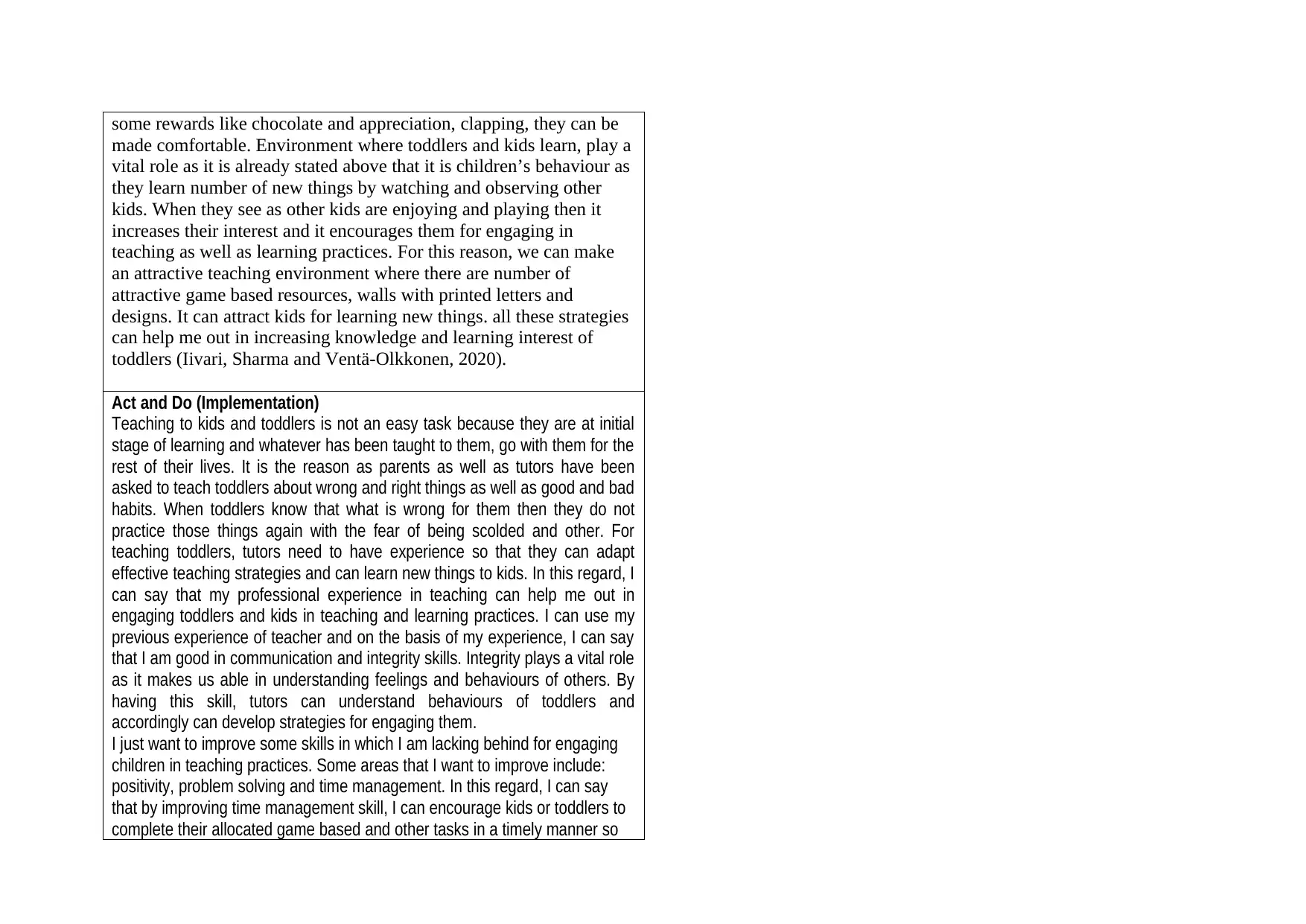
some rewards like chocolate and appreciation, clapping, they can be
made comfortable. Environment where toddlers and kids learn, play a
vital role as it is already stated above that it is children’s behaviour as
they learn number of new things by watching and observing other
kids. When they see as other kids are enjoying and playing then it
increases their interest and it encourages them for engaging in
teaching as well as learning practices. For this reason, we can make
an attractive teaching environment where there are number of
attractive game based resources, walls with printed letters and
designs. It can attract kids for learning new things. all these strategies
can help me out in increasing knowledge and learning interest of
toddlers (Iivari, Sharma and Ventä-Olkkonen, 2020).
Act and Do (Implementation)
Teaching to kids and toddlers is not an easy task because they are at initial
stage of learning and whatever has been taught to them, go with them for the
rest of their lives. It is the reason as parents as well as tutors have been
asked to teach toddlers about wrong and right things as well as good and bad
habits. When toddlers know that what is wrong for them then they do not
practice those things again with the fear of being scolded and other. For
teaching toddlers, tutors need to have experience so that they can adapt
effective teaching strategies and can learn new things to kids. In this regard, I
can say that my professional experience in teaching can help me out in
engaging toddlers and kids in teaching and learning practices. I can use my
previous experience of teacher and on the basis of my experience, I can say
that I am good in communication and integrity skills. Integrity plays a vital role
as it makes us able in understanding feelings and behaviours of others. By
having this skill, tutors can understand behaviours of toddlers and
accordingly can develop strategies for engaging them.
I just want to improve some skills in which I am lacking behind for engaging
children in teaching practices. Some areas that I want to improve include:
positivity, problem solving and time management. In this regard, I can say
that by improving time management skill, I can encourage kids or toddlers to
complete their allocated game based and other tasks in a timely manner so
made comfortable. Environment where toddlers and kids learn, play a
vital role as it is already stated above that it is children’s behaviour as
they learn number of new things by watching and observing other
kids. When they see as other kids are enjoying and playing then it
increases their interest and it encourages them for engaging in
teaching as well as learning practices. For this reason, we can make
an attractive teaching environment where there are number of
attractive game based resources, walls with printed letters and
designs. It can attract kids for learning new things. all these strategies
can help me out in increasing knowledge and learning interest of
toddlers (Iivari, Sharma and Ventä-Olkkonen, 2020).
Act and Do (Implementation)
Teaching to kids and toddlers is not an easy task because they are at initial
stage of learning and whatever has been taught to them, go with them for the
rest of their lives. It is the reason as parents as well as tutors have been
asked to teach toddlers about wrong and right things as well as good and bad
habits. When toddlers know that what is wrong for them then they do not
practice those things again with the fear of being scolded and other. For
teaching toddlers, tutors need to have experience so that they can adapt
effective teaching strategies and can learn new things to kids. In this regard, I
can say that my professional experience in teaching can help me out in
engaging toddlers and kids in teaching and learning practices. I can use my
previous experience of teacher and on the basis of my experience, I can say
that I am good in communication and integrity skills. Integrity plays a vital role
as it makes us able in understanding feelings and behaviours of others. By
having this skill, tutors can understand behaviours of toddlers and
accordingly can develop strategies for engaging them.
I just want to improve some skills in which I am lacking behind for engaging
children in teaching practices. Some areas that I want to improve include:
positivity, problem solving and time management. In this regard, I can say
that by improving time management skill, I can encourage kids or toddlers to
complete their allocated game based and other tasks in a timely manner so
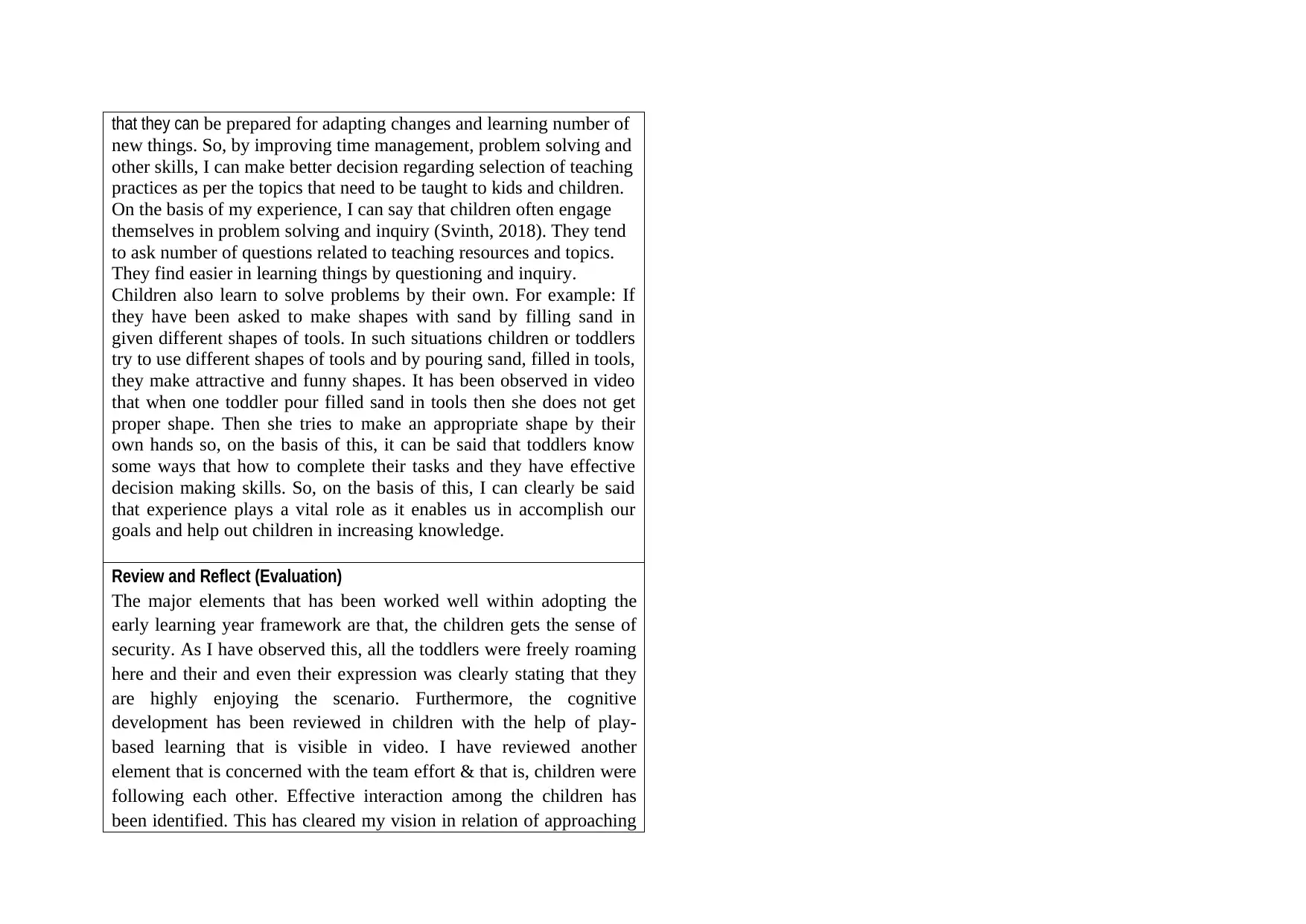
that they can be prepared for adapting changes and learning number of
new things. So, by improving time management, problem solving and
other skills, I can make better decision regarding selection of teaching
practices as per the topics that need to be taught to kids and children.
On the basis of my experience, I can say that children often engage
themselves in problem solving and inquiry (Svinth, 2018). They tend
to ask number of questions related to teaching resources and topics.
They find easier in learning things by questioning and inquiry.
Children also learn to solve problems by their own. For example: If
they have been asked to make shapes with sand by filling sand in
given different shapes of tools. In such situations children or toddlers
try to use different shapes of tools and by pouring sand, filled in tools,
they make attractive and funny shapes. It has been observed in video
that when one toddler pour filled sand in tools then she does not get
proper shape. Then she tries to make an appropriate shape by their
own hands so, on the basis of this, it can be said that toddlers know
some ways that how to complete their tasks and they have effective
decision making skills. So, on the basis of this, I can clearly be said
that experience plays a vital role as it enables us in accomplish our
goals and help out children in increasing knowledge.
Review and Reflect (Evaluation)
The major elements that has been worked well within adopting the
early learning year framework are that, the children gets the sense of
security. As I have observed this, all the toddlers were freely roaming
here and their and even their expression was clearly stating that they
are highly enjoying the scenario. Furthermore, the cognitive
development has been reviewed in children with the help of play-
based learning that is visible in video. I have reviewed another
element that is concerned with the team effort & that is, children were
following each other. Effective interaction among the children has
been identified. This has cleared my vision in relation of approaching
new things. So, by improving time management, problem solving and
other skills, I can make better decision regarding selection of teaching
practices as per the topics that need to be taught to kids and children.
On the basis of my experience, I can say that children often engage
themselves in problem solving and inquiry (Svinth, 2018). They tend
to ask number of questions related to teaching resources and topics.
They find easier in learning things by questioning and inquiry.
Children also learn to solve problems by their own. For example: If
they have been asked to make shapes with sand by filling sand in
given different shapes of tools. In such situations children or toddlers
try to use different shapes of tools and by pouring sand, filled in tools,
they make attractive and funny shapes. It has been observed in video
that when one toddler pour filled sand in tools then she does not get
proper shape. Then she tries to make an appropriate shape by their
own hands so, on the basis of this, it can be said that toddlers know
some ways that how to complete their tasks and they have effective
decision making skills. So, on the basis of this, I can clearly be said
that experience plays a vital role as it enables us in accomplish our
goals and help out children in increasing knowledge.
Review and Reflect (Evaluation)
The major elements that has been worked well within adopting the
early learning year framework are that, the children gets the sense of
security. As I have observed this, all the toddlers were freely roaming
here and their and even their expression was clearly stating that they
are highly enjoying the scenario. Furthermore, the cognitive
development has been reviewed in children with the help of play-
based learning that is visible in video. I have reviewed another
element that is concerned with the team effort & that is, children were
following each other. Effective interaction among the children has
been identified. This has cleared my vision in relation of approaching
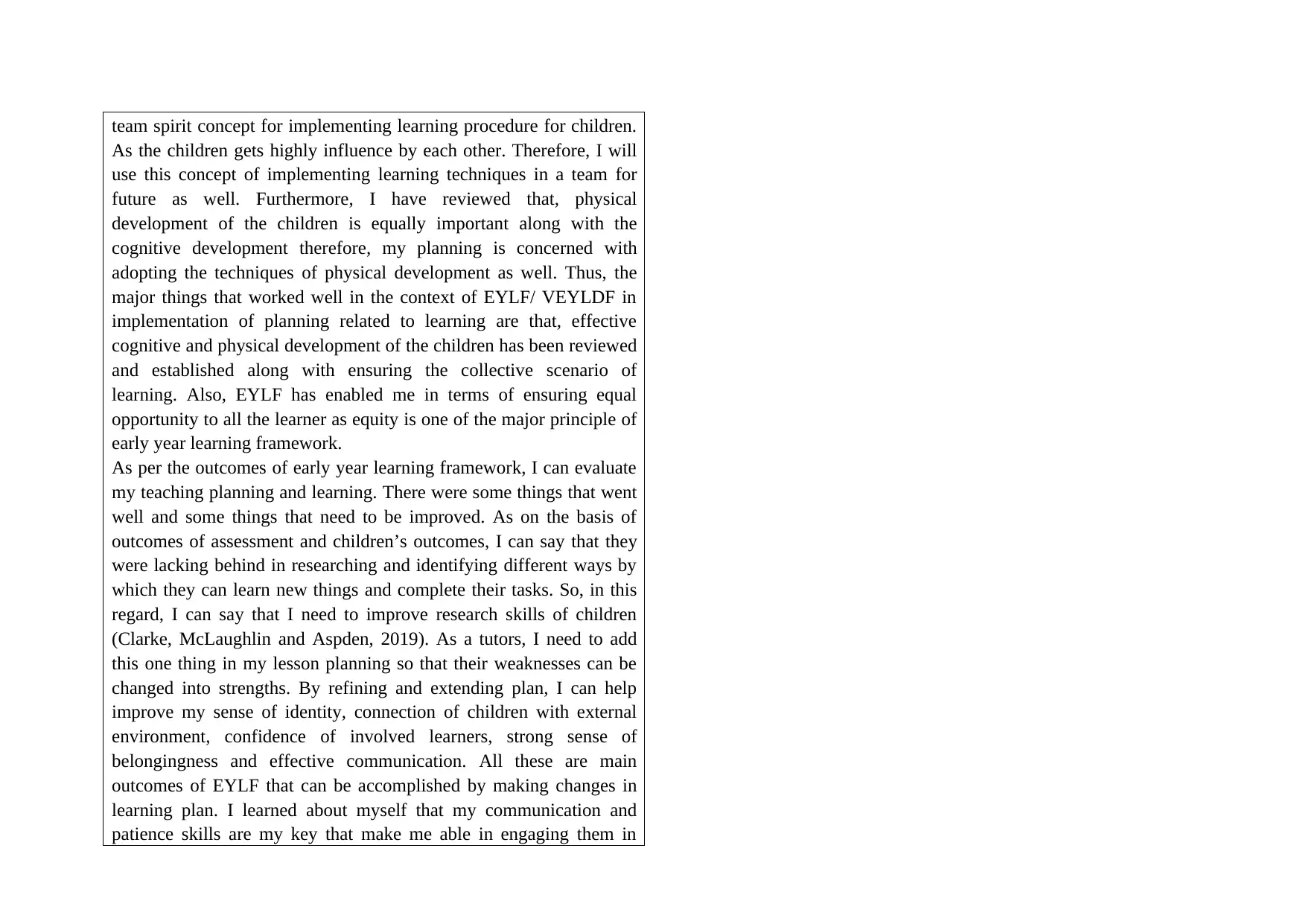
team spirit concept for implementing learning procedure for children.
As the children gets highly influence by each other. Therefore, I will
use this concept of implementing learning techniques in a team for
future as well. Furthermore, I have reviewed that, physical
development of the children is equally important along with the
cognitive development therefore, my planning is concerned with
adopting the techniques of physical development as well. Thus, the
major things that worked well in the context of EYLF/ VEYLDF in
implementation of planning related to learning are that, effective
cognitive and physical development of the children has been reviewed
and established along with ensuring the collective scenario of
learning. Also, EYLF has enabled me in terms of ensuring equal
opportunity to all the learner as equity is one of the major principle of
early year learning framework.
As per the outcomes of early year learning framework, I can evaluate
my teaching planning and learning. There were some things that went
well and some things that need to be improved. As on the basis of
outcomes of assessment and children’s outcomes, I can say that they
were lacking behind in researching and identifying different ways by
which they can learn new things and complete their tasks. So, in this
regard, I can say that I need to improve research skills of children
(Clarke, McLaughlin and Aspden, 2019). As a tutors, I need to add
this one thing in my lesson planning so that their weaknesses can be
changed into strengths. By refining and extending plan, I can help
improve my sense of identity, connection of children with external
environment, confidence of involved learners, strong sense of
belongingness and effective communication. All these are main
outcomes of EYLF that can be accomplished by making changes in
learning plan. I learned about myself that my communication and
patience skills are my key that make me able in engaging them in
As the children gets highly influence by each other. Therefore, I will
use this concept of implementing learning techniques in a team for
future as well. Furthermore, I have reviewed that, physical
development of the children is equally important along with the
cognitive development therefore, my planning is concerned with
adopting the techniques of physical development as well. Thus, the
major things that worked well in the context of EYLF/ VEYLDF in
implementation of planning related to learning are that, effective
cognitive and physical development of the children has been reviewed
and established along with ensuring the collective scenario of
learning. Also, EYLF has enabled me in terms of ensuring equal
opportunity to all the learner as equity is one of the major principle of
early year learning framework.
As per the outcomes of early year learning framework, I can evaluate
my teaching planning and learning. There were some things that went
well and some things that need to be improved. As on the basis of
outcomes of assessment and children’s outcomes, I can say that they
were lacking behind in researching and identifying different ways by
which they can learn new things and complete their tasks. So, in this
regard, I can say that I need to improve research skills of children
(Clarke, McLaughlin and Aspden, 2019). As a tutors, I need to add
this one thing in my lesson planning so that their weaknesses can be
changed into strengths. By refining and extending plan, I can help
improve my sense of identity, connection of children with external
environment, confidence of involved learners, strong sense of
belongingness and effective communication. All these are main
outcomes of EYLF that can be accomplished by making changes in
learning plan. I learned about myself that my communication and
patience skills are my key that make me able in engaging them in
Paraphrase This Document
Need a fresh take? Get an instant paraphrase of this document with our AI Paraphraser
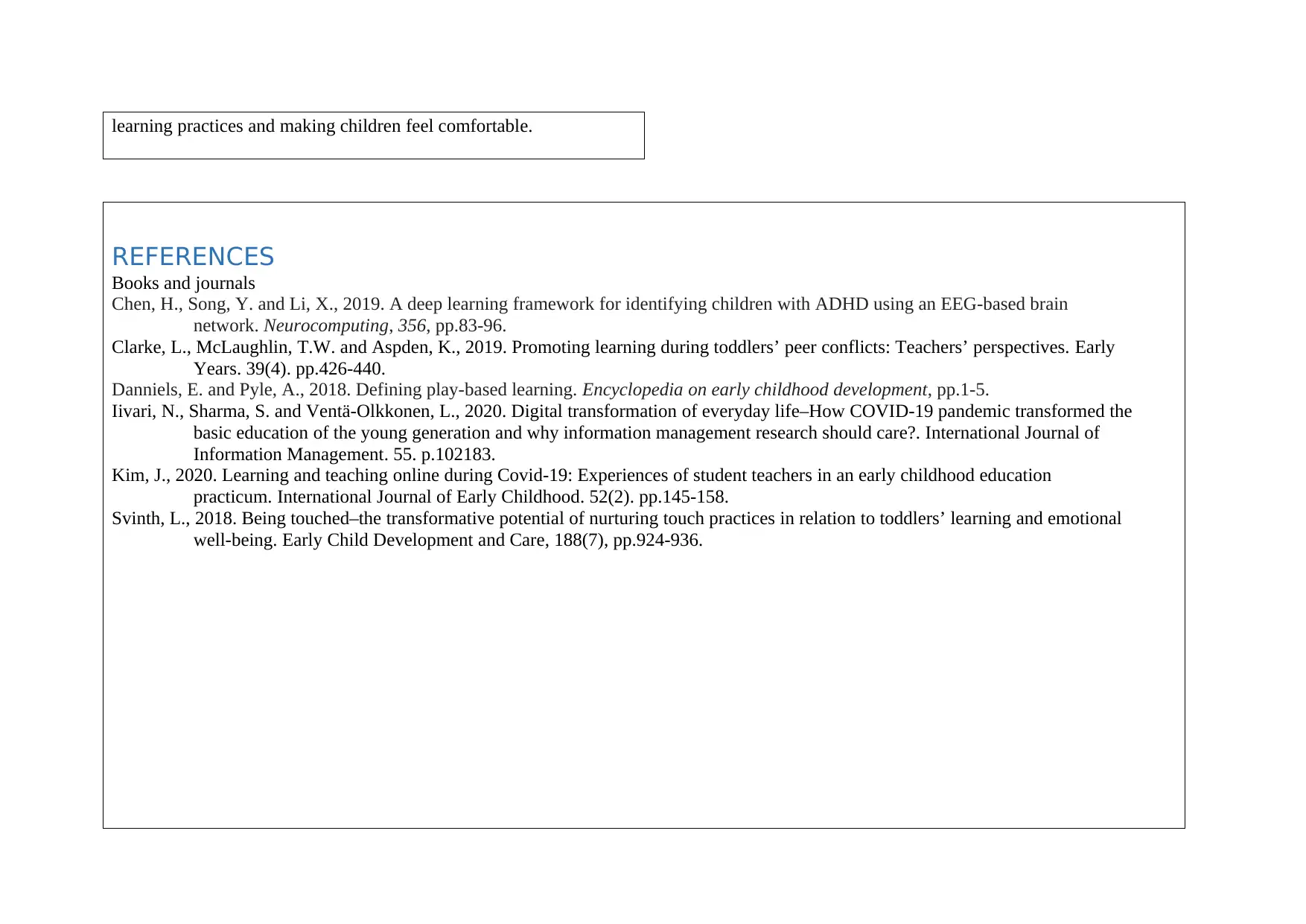
learning practices and making children feel comfortable.
REFERENCES
Books and journals
Chen, H., Song, Y. and Li, X., 2019. A deep learning framework for identifying children with ADHD using an EEG-based brain
network. Neurocomputing, 356, pp.83-96.
Clarke, L., McLaughlin, T.W. and Aspden, K., 2019. Promoting learning during toddlers’ peer conflicts: Teachers’ perspectives. Early
Years. 39(4). pp.426-440.
Danniels, E. and Pyle, A., 2018. Defining play-based learning. Encyclopedia on early childhood development, pp.1-5.
Iivari, N., Sharma, S. and Ventä-Olkkonen, L., 2020. Digital transformation of everyday life–How COVID-19 pandemic transformed the
basic education of the young generation and why information management research should care?. International Journal of
Information Management. 55. p.102183.
Kim, J., 2020. Learning and teaching online during Covid-19: Experiences of student teachers in an early childhood education
practicum. International Journal of Early Childhood. 52(2). pp.145-158.
Svinth, L., 2018. Being touched–the transformative potential of nurturing touch practices in relation to toddlers’ learning and emotional
well-being. Early Child Development and Care, 188(7), pp.924-936.
REFERENCES
Books and journals
Chen, H., Song, Y. and Li, X., 2019. A deep learning framework for identifying children with ADHD using an EEG-based brain
network. Neurocomputing, 356, pp.83-96.
Clarke, L., McLaughlin, T.W. and Aspden, K., 2019. Promoting learning during toddlers’ peer conflicts: Teachers’ perspectives. Early
Years. 39(4). pp.426-440.
Danniels, E. and Pyle, A., 2018. Defining play-based learning. Encyclopedia on early childhood development, pp.1-5.
Iivari, N., Sharma, S. and Ventä-Olkkonen, L., 2020. Digital transformation of everyday life–How COVID-19 pandemic transformed the
basic education of the young generation and why information management research should care?. International Journal of
Information Management. 55. p.102183.
Kim, J., 2020. Learning and teaching online during Covid-19: Experiences of student teachers in an early childhood education
practicum. International Journal of Early Childhood. 52(2). pp.145-158.
Svinth, L., 2018. Being touched–the transformative potential of nurturing touch practices in relation to toddlers’ learning and emotional
well-being. Early Child Development and Care, 188(7), pp.924-936.

1 out of 9
Related Documents
Your All-in-One AI-Powered Toolkit for Academic Success.
+13062052269
info@desklib.com
Available 24*7 on WhatsApp / Email
![[object Object]](/_next/static/media/star-bottom.7253800d.svg)
Unlock your academic potential
© 2024 | Zucol Services PVT LTD | All rights reserved.





